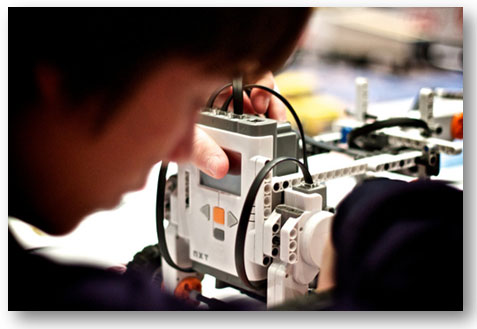IHITZA 46 - DOING OUR OWN THING
LEGO COMPETITION, COMBINING SCIENCE AND TECHNOLOGY
 First Lego League (FLL) is a competition for children between 10 and 16. They have a challenge: designing and programming a robot following FLL values. So participants will have to make sure they have fully understood the competition rules.
First Lego League (FLL) is a competition for children between 10 and 16. They have a challenge: designing and programming a robot following FLL values. So participants will have to make sure they have fully understood the competition rules.
Each group must have at least one adult trainer and no group can have more than ten members. Children from all over the world (groups, schools or institutions) can take part in the FLL competition and, in this way, acquire scientific and technological knowledge. They will also develop several skills which will be useful to them in their professional and personal lives.
Teachers must divide the challenge into three stages: the scientific project, designing and programming the robot, and the competition values.
Pupils have to carry out a scientific research project in order to find a solution for a real subject put forward as part of the competition. They also have to design and program a robot which will have to pass certain tests. There is scoring for each test and pupils must get as many points as possible during a period of two and a half minutes. While doing all of this, the competition values (group character, friendly competition spirit, enjoying yourself…) have to be followed and it must be checked that the pupils have taken these values in.
WORKING FOR OSPREY CONSERVATION
 Urdaibai Bird Centre and Txingudi Marsh Eco-House are working together on a project to use ospreys for didactic purposes and, at the same time, do research about them and track them. The Basque Government's Environment and Territorial Policies Department and Bizkaia Regional Government have financed the project and coordinated the Environmental Centres.
Urdaibai Bird Centre and Txingudi Marsh Eco-House are working together on a project to use ospreys for didactic purposes and, at the same time, do research about them and track them. The Basque Government's Environment and Territorial Policies Department and Bizkaia Regional Government have financed the project and coordinated the Environmental Centres.
The ospreys are birds which migrate from the north of Europe to below the Sahara and every year they stop at Urdaibai and Txingudi. So this project’s main objective is to use the species as a didactic resource, but not its only one: it also aims to encourage research into ospreys and tracking them, pupils taking part in osprey conservation and investigating how to adapt new technology for use in education.
All schools in the Basque Country can take part in this project; all pupils from 3rd Year Primary Education to 4th Year Compulsory Secondary Education. Furthermore, the aim is to take the project to a still wider field: free guided tours will be given from October 1st to 30th.
After the schools have completed their work and the guided tours have been given, the results will be pooled around mid-March 2016 in order to assess them and learn about the teachers' experiences. And if schools wish to share the work they have done, they will be able to do so on the website http://urdaibaiospreys.eu/eu/esperientziak.
Schools interested must sign up at the centre they wish to visit.
Urdaibai Bird Centre: 699 839 202
Txingudi Eco-House: 943 619 389
GAME
Ambientech, a fun way to learn
Ambientech is a game which has 300 animations and interactive games and which helps children to learn in class and at home. While playing these games pupils learn about water, energy, living creatures, materials, health and social issues in a fun, easy way.
In 2005 the objective was to have points of reference in science and technology and in this led to the creation of the educational area, designed to help protect the environment. With the objective of making studying science, technology and the environment more wide-spread and easier, and making pupils more motivated to study, a specific methodology was created in order for pupils to become aware of current environmental problems.
Greenpeace's Interactive Game
Children will enjoy themselves playing Greenpeace's interactive game. Watching an animation takes them on a walk on which they find out about the problems created by pollution and consumerism. The subjects which will be examined on the interactive walk are advertising, shopping and mobility, and Eva will accompany the pupils on the walk. Children choose their own routes, the way they want to go and the order they want to visit places, and Eva tells them the information and details about each place they visit. The game which Greenpeace has made is interesting and effective: pupils will reflect about the way we behave and be able to make suggestions about how to make what we do sustainable.